BUS804: True Fruits' International Strategy Case Study Analysis
VerifiedAdded on 2023/06/13
|14
|3644
|101
Case Study
AI Summary
This case study solution provides a comprehensive analysis of True Fruits' international business strategy, focusing on the challenges the company faces as it seeks to expand into new markets. It identifies key issues such as increasing competition, raw material sourcing, promotional strategies, and product diversification. The analysis considers the impact of these challenges on major stakeholders, including customers, suppliers, founders, and regulatory bodies. Alternative solutions, derived from Ansoff's growth matrix, are evaluated, including product diversification, market development, and product development. Ultimately, product diversification is recommended as the most suitable strategy, given the growing global demand for juice products and the potential for True Fruits to innovate with new flavors and healthier options. The solution also addresses managerial implications and provides insights into the complexities of True Fruits' internationalization efforts.
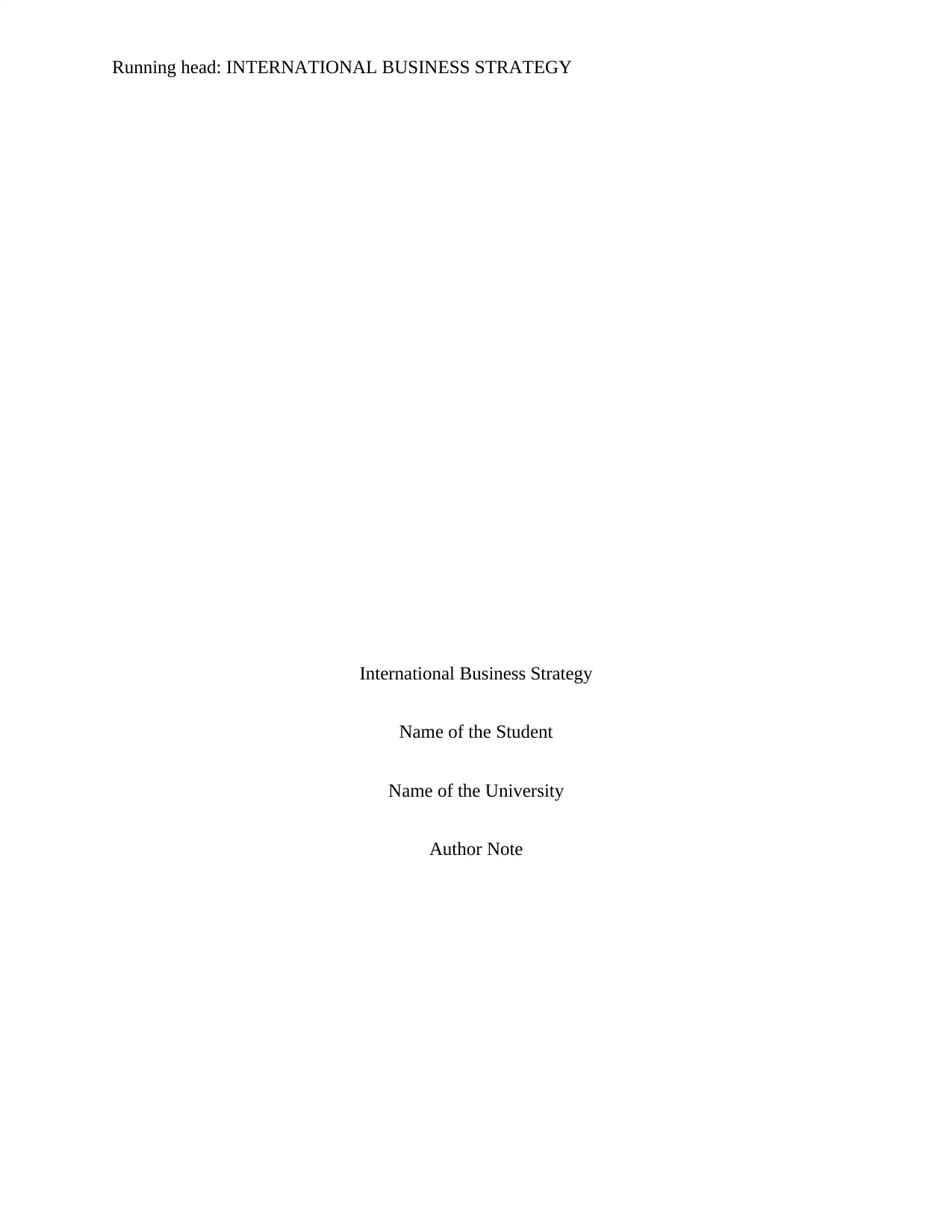
Running head: INTERNATIONAL BUSINESS STRATEGY
International Business Strategy
Name of the Student
Name of the University
Author Note
International Business Strategy
Name of the Student
Name of the University
Author Note
Paraphrase This Document
Need a fresh take? Get an instant paraphrase of this document with our AI Paraphraser
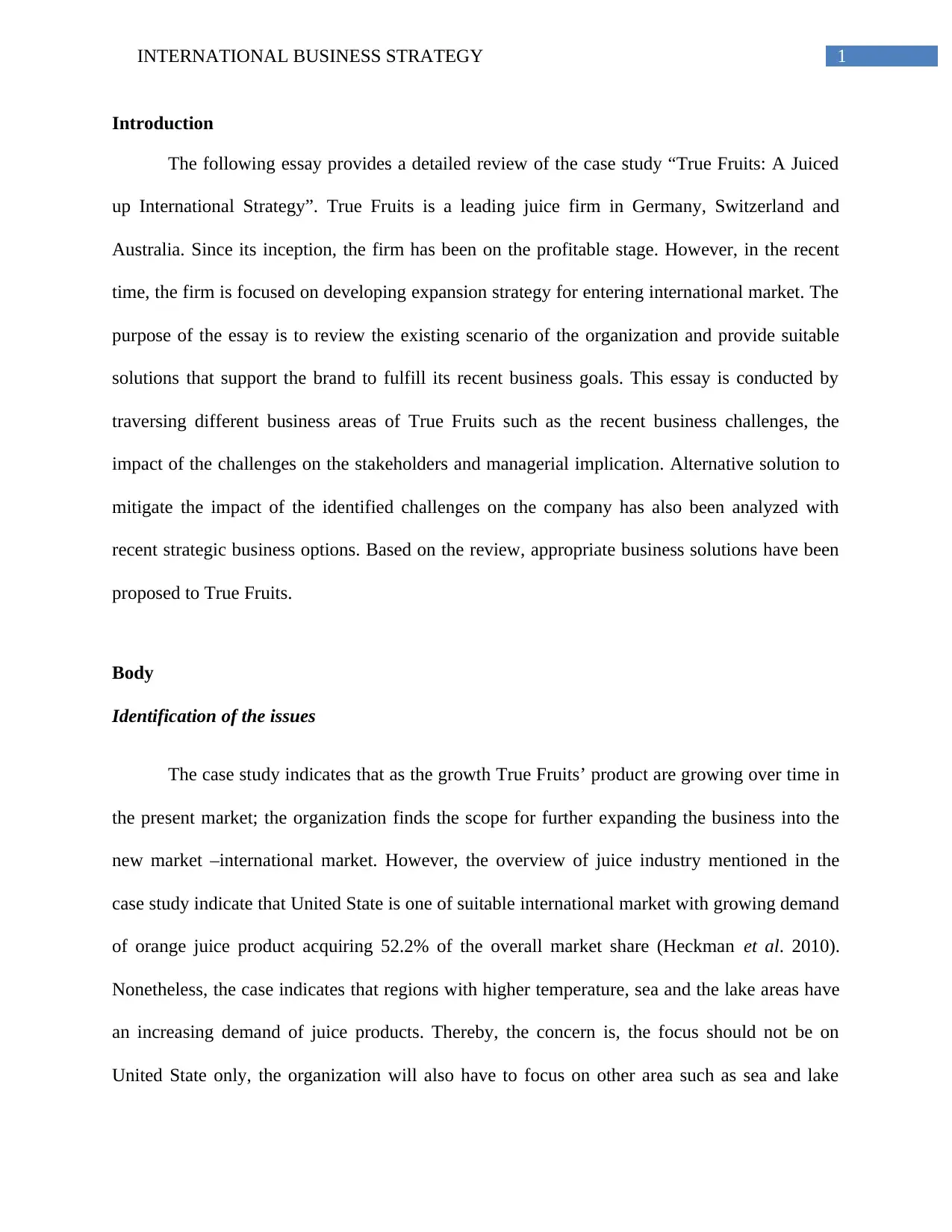
1INTERNATIONAL BUSINESS STRATEGY
Introduction
The following essay provides a detailed review of the case study “True Fruits: A Juiced
up International Strategy”. True Fruits is a leading juice firm in Germany, Switzerland and
Australia. Since its inception, the firm has been on the profitable stage. However, in the recent
time, the firm is focused on developing expansion strategy for entering international market. The
purpose of the essay is to review the existing scenario of the organization and provide suitable
solutions that support the brand to fulfill its recent business goals. This essay is conducted by
traversing different business areas of True Fruits such as the recent business challenges, the
impact of the challenges on the stakeholders and managerial implication. Alternative solution to
mitigate the impact of the identified challenges on the company has also been analyzed with
recent strategic business options. Based on the review, appropriate business solutions have been
proposed to True Fruits.
Body
Identification of the issues
The case study indicates that as the growth True Fruits’ product are growing over time in
the present market; the organization finds the scope for further expanding the business into the
new market –international market. However, the overview of juice industry mentioned in the
case study indicate that United State is one of suitable international market with growing demand
of orange juice product acquiring 52.2% of the overall market share (Heckman et al. 2010).
Nonetheless, the case indicates that regions with higher temperature, sea and the lake areas have
an increasing demand of juice products. Thereby, the concern is, the focus should not be on
United State only, the organization will also have to focus on other area such as sea and lake
Introduction
The following essay provides a detailed review of the case study “True Fruits: A Juiced
up International Strategy”. True Fruits is a leading juice firm in Germany, Switzerland and
Australia. Since its inception, the firm has been on the profitable stage. However, in the recent
time, the firm is focused on developing expansion strategy for entering international market. The
purpose of the essay is to review the existing scenario of the organization and provide suitable
solutions that support the brand to fulfill its recent business goals. This essay is conducted by
traversing different business areas of True Fruits such as the recent business challenges, the
impact of the challenges on the stakeholders and managerial implication. Alternative solution to
mitigate the impact of the identified challenges on the company has also been analyzed with
recent strategic business options. Based on the review, appropriate business solutions have been
proposed to True Fruits.
Body
Identification of the issues
The case study indicates that as the growth True Fruits’ product are growing over time in
the present market; the organization finds the scope for further expanding the business into the
new market –international market. However, the overview of juice industry mentioned in the
case study indicate that United State is one of suitable international market with growing demand
of orange juice product acquiring 52.2% of the overall market share (Heckman et al. 2010).
Nonetheless, the case indicates that regions with higher temperature, sea and the lake areas have
an increasing demand of juice products. Thereby, the concern is, the focus should not be on
United State only, the organization will also have to focus on other area such as sea and lake
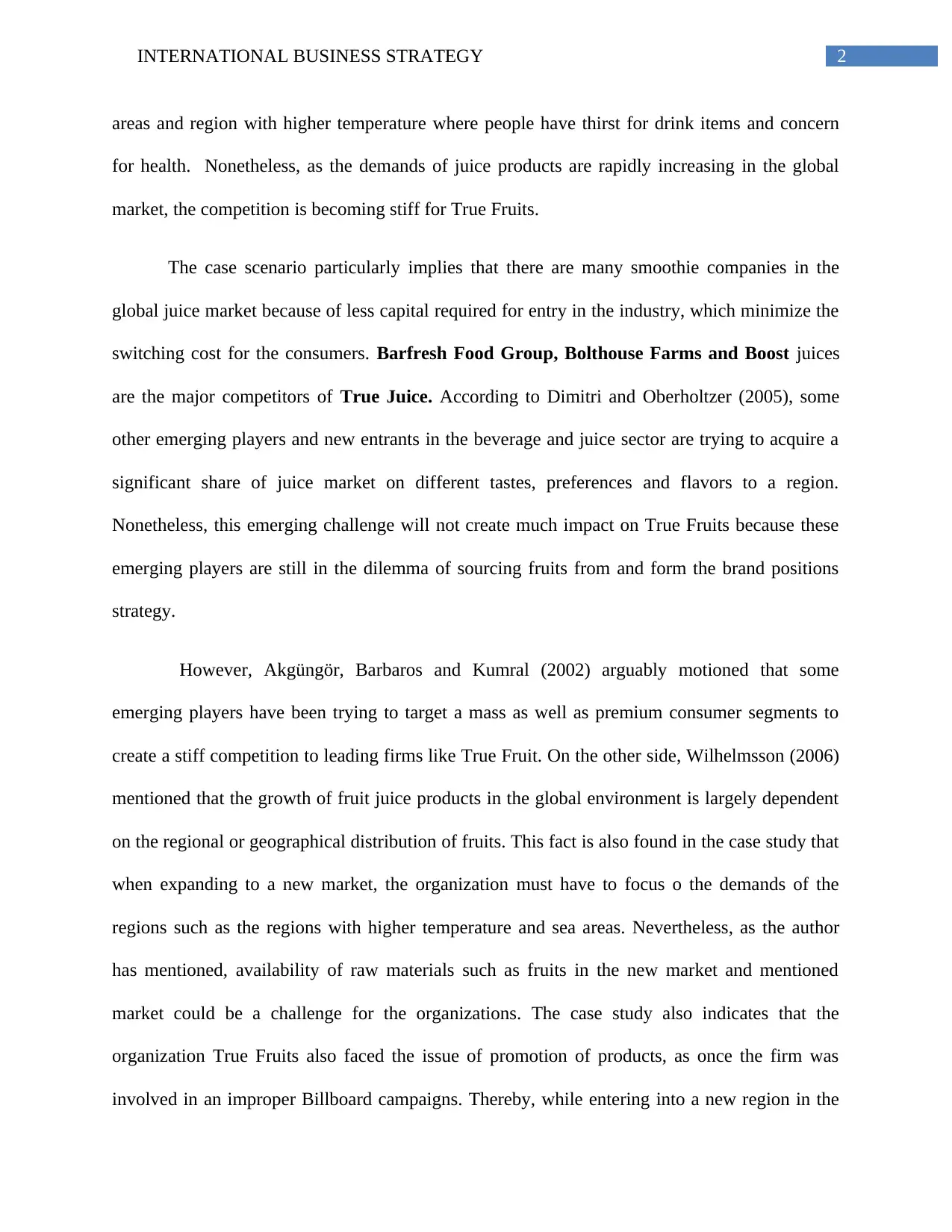
2INTERNATIONAL BUSINESS STRATEGY
areas and region with higher temperature where people have thirst for drink items and concern
for health. Nonetheless, as the demands of juice products are rapidly increasing in the global
market, the competition is becoming stiff for True Fruits.
The case scenario particularly implies that there are many smoothie companies in the
global juice market because of less capital required for entry in the industry, which minimize the
switching cost for the consumers. Barfresh Food Group, Bolthouse Farms and Boost juices
are the major competitors of True Juice. According to Dimitri and Oberholtzer (2005), some
other emerging players and new entrants in the beverage and juice sector are trying to acquire a
significant share of juice market on different tastes, preferences and flavors to a region.
Nonetheless, this emerging challenge will not create much impact on True Fruits because these
emerging players are still in the dilemma of sourcing fruits from and form the brand positions
strategy.
However, Akgüngör, Barbaros and Kumral (2002) arguably motioned that some
emerging players have been trying to target a mass as well as premium consumer segments to
create a stiff competition to leading firms like True Fruit. On the other side, Wilhelmsson (2006)
mentioned that the growth of fruit juice products in the global environment is largely dependent
on the regional or geographical distribution of fruits. This fact is also found in the case study that
when expanding to a new market, the organization must have to focus o the demands of the
regions such as the regions with higher temperature and sea areas. Nevertheless, as the author
has mentioned, availability of raw materials such as fruits in the new market and mentioned
market could be a challenge for the organizations. The case study also indicates that the
organization True Fruits also faced the issue of promotion of products, as once the firm was
involved in an improper Billboard campaigns. Thereby, while entering into a new region in the
areas and region with higher temperature where people have thirst for drink items and concern
for health. Nonetheless, as the demands of juice products are rapidly increasing in the global
market, the competition is becoming stiff for True Fruits.
The case scenario particularly implies that there are many smoothie companies in the
global juice market because of less capital required for entry in the industry, which minimize the
switching cost for the consumers. Barfresh Food Group, Bolthouse Farms and Boost juices
are the major competitors of True Juice. According to Dimitri and Oberholtzer (2005), some
other emerging players and new entrants in the beverage and juice sector are trying to acquire a
significant share of juice market on different tastes, preferences and flavors to a region.
Nonetheless, this emerging challenge will not create much impact on True Fruits because these
emerging players are still in the dilemma of sourcing fruits from and form the brand positions
strategy.
However, Akgüngör, Barbaros and Kumral (2002) arguably motioned that some
emerging players have been trying to target a mass as well as premium consumer segments to
create a stiff competition to leading firms like True Fruit. On the other side, Wilhelmsson (2006)
mentioned that the growth of fruit juice products in the global environment is largely dependent
on the regional or geographical distribution of fruits. This fact is also found in the case study that
when expanding to a new market, the organization must have to focus o the demands of the
regions such as the regions with higher temperature and sea areas. Nevertheless, as the author
has mentioned, availability of raw materials such as fruits in the new market and mentioned
market could be a challenge for the organizations. The case study also indicates that the
organization True Fruits also faced the issue of promotion of products, as once the firm was
involved in an improper Billboard campaigns. Thereby, while entering into a new region in the
⊘ This is a preview!⊘
Do you want full access?
Subscribe today to unlock all pages.

Trusted by 1+ million students worldwide
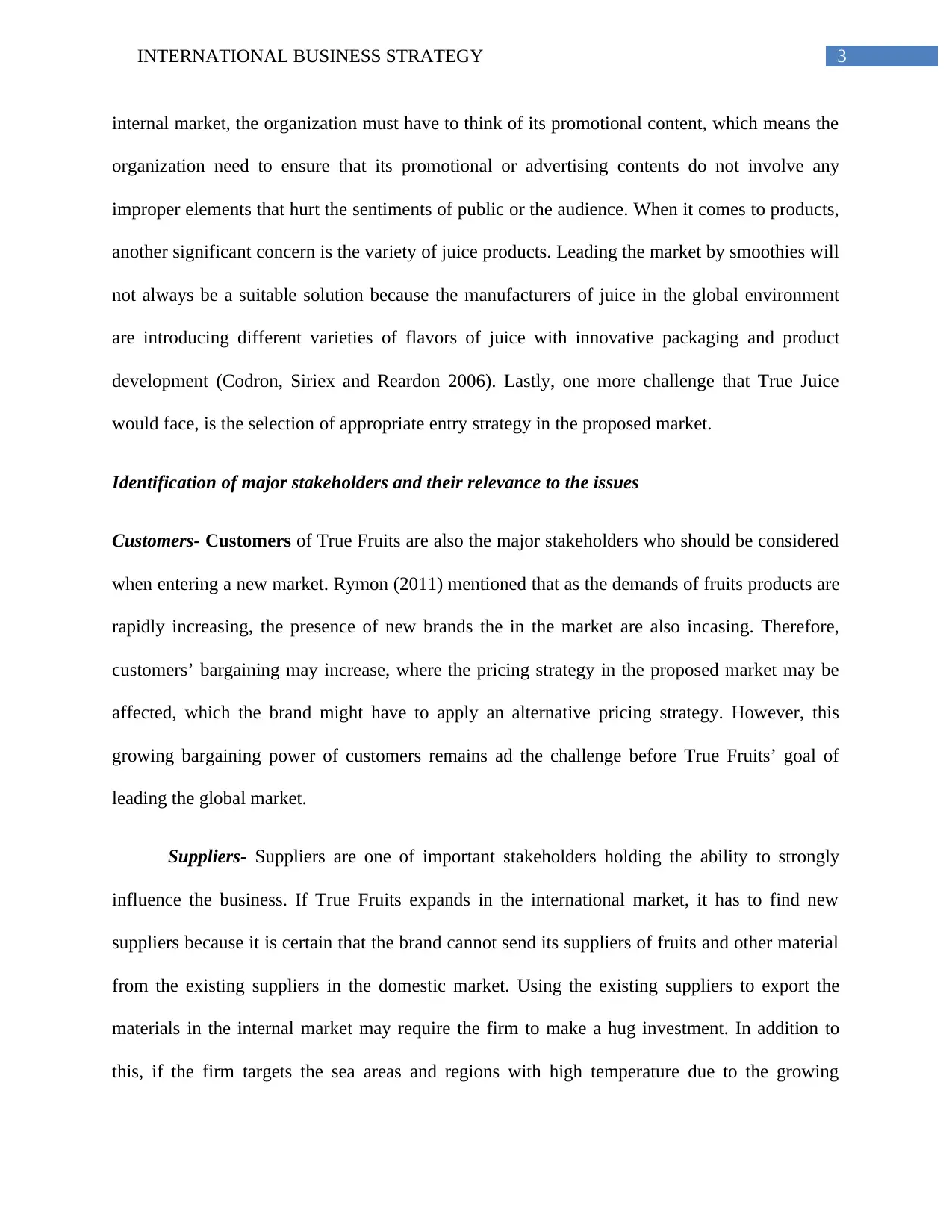
3INTERNATIONAL BUSINESS STRATEGY
internal market, the organization must have to think of its promotional content, which means the
organization need to ensure that its promotional or advertising contents do not involve any
improper elements that hurt the sentiments of public or the audience. When it comes to products,
another significant concern is the variety of juice products. Leading the market by smoothies will
not always be a suitable solution because the manufacturers of juice in the global environment
are introducing different varieties of flavors of juice with innovative packaging and product
development (Codron, Siriex and Reardon 2006). Lastly, one more challenge that True Juice
would face, is the selection of appropriate entry strategy in the proposed market.
Identification of major stakeholders and their relevance to the issues
Customers- Customers of True Fruits are also the major stakeholders who should be considered
when entering a new market. Rymon (2011) mentioned that as the demands of fruits products are
rapidly increasing, the presence of new brands the in the market are also incasing. Therefore,
customers’ bargaining may increase, where the pricing strategy in the proposed market may be
affected, which the brand might have to apply an alternative pricing strategy. However, this
growing bargaining power of customers remains ad the challenge before True Fruits’ goal of
leading the global market.
Suppliers- Suppliers are one of important stakeholders holding the ability to strongly
influence the business. If True Fruits expands in the international market, it has to find new
suppliers because it is certain that the brand cannot send its suppliers of fruits and other material
from the existing suppliers in the domestic market. Using the existing suppliers to export the
materials in the internal market may require the firm to make a hug investment. In addition to
this, if the firm targets the sea areas and regions with high temperature due to the growing
internal market, the organization must have to think of its promotional content, which means the
organization need to ensure that its promotional or advertising contents do not involve any
improper elements that hurt the sentiments of public or the audience. When it comes to products,
another significant concern is the variety of juice products. Leading the market by smoothies will
not always be a suitable solution because the manufacturers of juice in the global environment
are introducing different varieties of flavors of juice with innovative packaging and product
development (Codron, Siriex and Reardon 2006). Lastly, one more challenge that True Juice
would face, is the selection of appropriate entry strategy in the proposed market.
Identification of major stakeholders and their relevance to the issues
Customers- Customers of True Fruits are also the major stakeholders who should be considered
when entering a new market. Rymon (2011) mentioned that as the demands of fruits products are
rapidly increasing, the presence of new brands the in the market are also incasing. Therefore,
customers’ bargaining may increase, where the pricing strategy in the proposed market may be
affected, which the brand might have to apply an alternative pricing strategy. However, this
growing bargaining power of customers remains ad the challenge before True Fruits’ goal of
leading the global market.
Suppliers- Suppliers are one of important stakeholders holding the ability to strongly
influence the business. If True Fruits expands in the international market, it has to find new
suppliers because it is certain that the brand cannot send its suppliers of fruits and other material
from the existing suppliers in the domestic market. Using the existing suppliers to export the
materials in the internal market may require the firm to make a hug investment. In addition to
this, if the firm targets the sea areas and regions with high temperature due to the growing
Paraphrase This Document
Need a fresh take? Get an instant paraphrase of this document with our AI Paraphraser
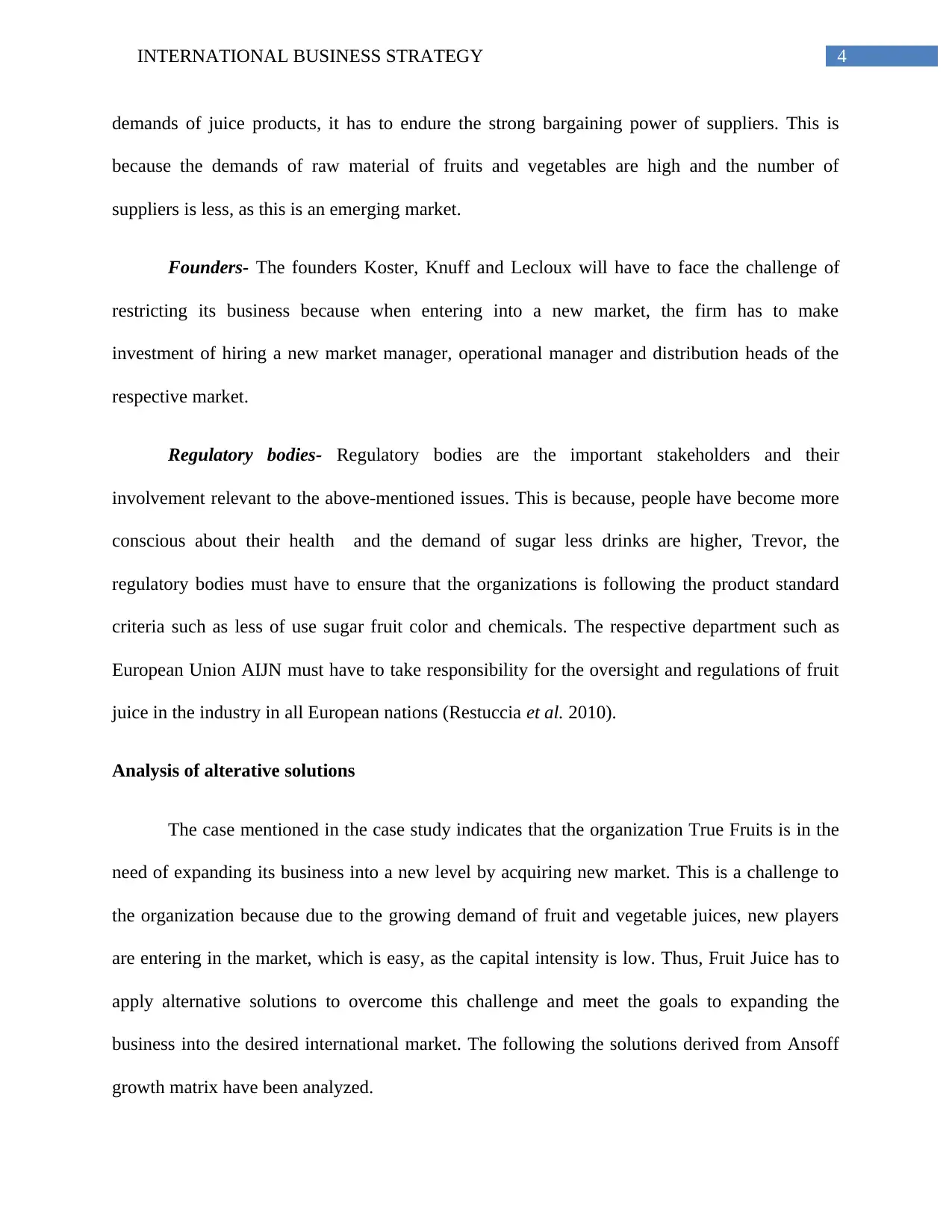
4INTERNATIONAL BUSINESS STRATEGY
demands of juice products, it has to endure the strong bargaining power of suppliers. This is
because the demands of raw material of fruits and vegetables are high and the number of
suppliers is less, as this is an emerging market.
Founders- The founders Koster, Knuff and Lecloux will have to face the challenge of
restricting its business because when entering into a new market, the firm has to make
investment of hiring a new market manager, operational manager and distribution heads of the
respective market.
Regulatory bodies- Regulatory bodies are the important stakeholders and their
involvement relevant to the above-mentioned issues. This is because, people have become more
conscious about their health and the demand of sugar less drinks are higher, Trevor, the
regulatory bodies must have to ensure that the organizations is following the product standard
criteria such as less of use sugar fruit color and chemicals. The respective department such as
European Union AIJN must have to take responsibility for the oversight and regulations of fruit
juice in the industry in all European nations (Restuccia et al. 2010).
Analysis of alterative solutions
The case mentioned in the case study indicates that the organization True Fruits is in the
need of expanding its business into a new level by acquiring new market. This is a challenge to
the organization because due to the growing demand of fruit and vegetable juices, new players
are entering in the market, which is easy, as the capital intensity is low. Thus, Fruit Juice has to
apply alternative solutions to overcome this challenge and meet the goals to expanding the
business into the desired international market. The following the solutions derived from Ansoff
growth matrix have been analyzed.
demands of juice products, it has to endure the strong bargaining power of suppliers. This is
because the demands of raw material of fruits and vegetables are high and the number of
suppliers is less, as this is an emerging market.
Founders- The founders Koster, Knuff and Lecloux will have to face the challenge of
restricting its business because when entering into a new market, the firm has to make
investment of hiring a new market manager, operational manager and distribution heads of the
respective market.
Regulatory bodies- Regulatory bodies are the important stakeholders and their
involvement relevant to the above-mentioned issues. This is because, people have become more
conscious about their health and the demand of sugar less drinks are higher, Trevor, the
regulatory bodies must have to ensure that the organizations is following the product standard
criteria such as less of use sugar fruit color and chemicals. The respective department such as
European Union AIJN must have to take responsibility for the oversight and regulations of fruit
juice in the industry in all European nations (Restuccia et al. 2010).
Analysis of alterative solutions
The case mentioned in the case study indicates that the organization True Fruits is in the
need of expanding its business into a new level by acquiring new market. This is a challenge to
the organization because due to the growing demand of fruit and vegetable juices, new players
are entering in the market, which is easy, as the capital intensity is low. Thus, Fruit Juice has to
apply alternative solutions to overcome this challenge and meet the goals to expanding the
business into the desired international market. The following the solutions derived from Ansoff
growth matrix have been analyzed.
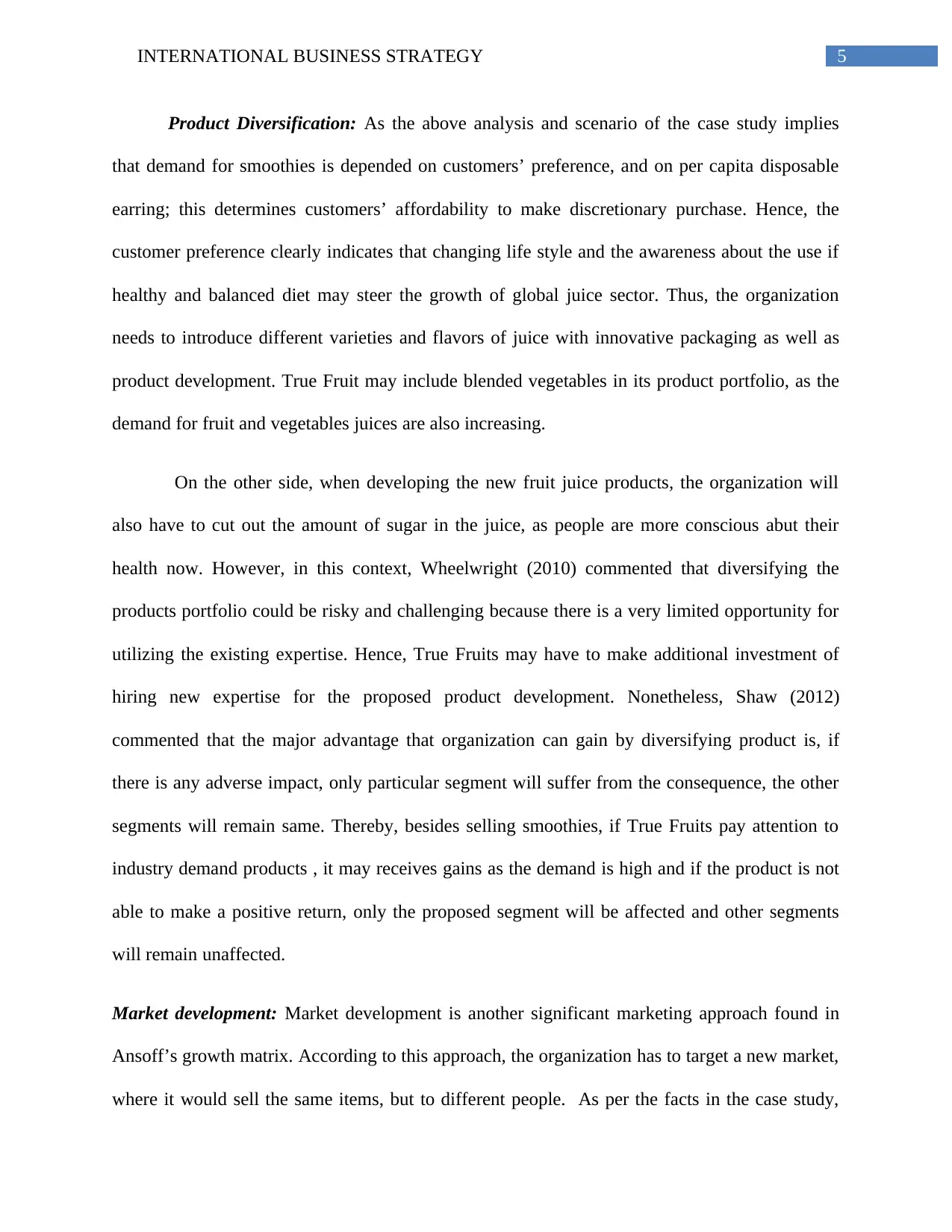
5INTERNATIONAL BUSINESS STRATEGY
Product Diversification: As the above analysis and scenario of the case study implies
that demand for smoothies is depended on customers’ preference, and on per capita disposable
earring; this determines customers’ affordability to make discretionary purchase. Hence, the
customer preference clearly indicates that changing life style and the awareness about the use if
healthy and balanced diet may steer the growth of global juice sector. Thus, the organization
needs to introduce different varieties and flavors of juice with innovative packaging as well as
product development. True Fruit may include blended vegetables in its product portfolio, as the
demand for fruit and vegetables juices are also increasing.
On the other side, when developing the new fruit juice products, the organization will
also have to cut out the amount of sugar in the juice, as people are more conscious abut their
health now. However, in this context, Wheelwright (2010) commented that diversifying the
products portfolio could be risky and challenging because there is a very limited opportunity for
utilizing the existing expertise. Hence, True Fruits may have to make additional investment of
hiring new expertise for the proposed product development. Nonetheless, Shaw (2012)
commented that the major advantage that organization can gain by diversifying product is, if
there is any adverse impact, only particular segment will suffer from the consequence, the other
segments will remain same. Thereby, besides selling smoothies, if True Fruits pay attention to
industry demand products , it may receives gains as the demand is high and if the product is not
able to make a positive return, only the proposed segment will be affected and other segments
will remain unaffected.
Market development: Market development is another significant marketing approach found in
Ansoff’s growth matrix. According to this approach, the organization has to target a new market,
where it would sell the same items, but to different people. As per the facts in the case study,
Product Diversification: As the above analysis and scenario of the case study implies
that demand for smoothies is depended on customers’ preference, and on per capita disposable
earring; this determines customers’ affordability to make discretionary purchase. Hence, the
customer preference clearly indicates that changing life style and the awareness about the use if
healthy and balanced diet may steer the growth of global juice sector. Thus, the organization
needs to introduce different varieties and flavors of juice with innovative packaging as well as
product development. True Fruit may include blended vegetables in its product portfolio, as the
demand for fruit and vegetables juices are also increasing.
On the other side, when developing the new fruit juice products, the organization will
also have to cut out the amount of sugar in the juice, as people are more conscious abut their
health now. However, in this context, Wheelwright (2010) commented that diversifying the
products portfolio could be risky and challenging because there is a very limited opportunity for
utilizing the existing expertise. Hence, True Fruits may have to make additional investment of
hiring new expertise for the proposed product development. Nonetheless, Shaw (2012)
commented that the major advantage that organization can gain by diversifying product is, if
there is any adverse impact, only particular segment will suffer from the consequence, the other
segments will remain same. Thereby, besides selling smoothies, if True Fruits pay attention to
industry demand products , it may receives gains as the demand is high and if the product is not
able to make a positive return, only the proposed segment will be affected and other segments
will remain unaffected.
Market development: Market development is another significant marketing approach found in
Ansoff’s growth matrix. According to this approach, the organization has to target a new market,
where it would sell the same items, but to different people. As per the facts in the case study,
⊘ This is a preview!⊘
Do you want full access?
Subscribe today to unlock all pages.

Trusted by 1+ million students worldwide
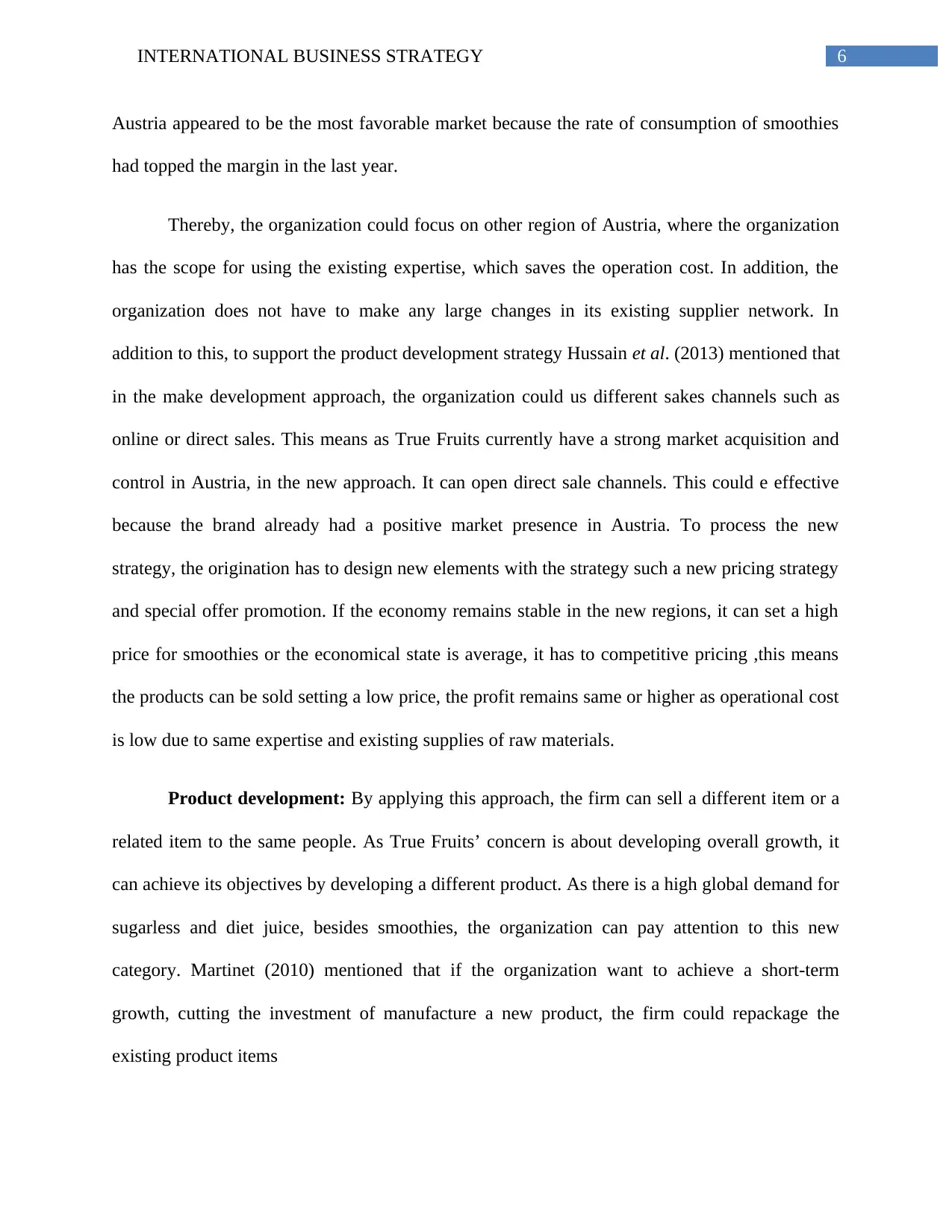
6INTERNATIONAL BUSINESS STRATEGY
Austria appeared to be the most favorable market because the rate of consumption of smoothies
had topped the margin in the last year.
Thereby, the organization could focus on other region of Austria, where the organization
has the scope for using the existing expertise, which saves the operation cost. In addition, the
organization does not have to make any large changes in its existing supplier network. In
addition to this, to support the product development strategy Hussain et al. (2013) mentioned that
in the make development approach, the organization could us different sakes channels such as
online or direct sales. This means as True Fruits currently have a strong market acquisition and
control in Austria, in the new approach. It can open direct sale channels. This could e effective
because the brand already had a positive market presence in Austria. To process the new
strategy, the origination has to design new elements with the strategy such a new pricing strategy
and special offer promotion. If the economy remains stable in the new regions, it can set a high
price for smoothies or the economical state is average, it has to competitive pricing ,this means
the products can be sold setting a low price, the profit remains same or higher as operational cost
is low due to same expertise and existing supplies of raw materials.
Product development: By applying this approach, the firm can sell a different item or a
related item to the same people. As True Fruits’ concern is about developing overall growth, it
can achieve its objectives by developing a different product. As there is a high global demand for
sugarless and diet juice, besides smoothies, the organization can pay attention to this new
category. Martinet (2010) mentioned that if the organization want to achieve a short-term
growth, cutting the investment of manufacture a new product, the firm could repackage the
existing product items
Austria appeared to be the most favorable market because the rate of consumption of smoothies
had topped the margin in the last year.
Thereby, the organization could focus on other region of Austria, where the organization
has the scope for using the existing expertise, which saves the operation cost. In addition, the
organization does not have to make any large changes in its existing supplier network. In
addition to this, to support the product development strategy Hussain et al. (2013) mentioned that
in the make development approach, the organization could us different sakes channels such as
online or direct sales. This means as True Fruits currently have a strong market acquisition and
control in Austria, in the new approach. It can open direct sale channels. This could e effective
because the brand already had a positive market presence in Austria. To process the new
strategy, the origination has to design new elements with the strategy such a new pricing strategy
and special offer promotion. If the economy remains stable in the new regions, it can set a high
price for smoothies or the economical state is average, it has to competitive pricing ,this means
the products can be sold setting a low price, the profit remains same or higher as operational cost
is low due to same expertise and existing supplies of raw materials.
Product development: By applying this approach, the firm can sell a different item or a
related item to the same people. As True Fruits’ concern is about developing overall growth, it
can achieve its objectives by developing a different product. As there is a high global demand for
sugarless and diet juice, besides smoothies, the organization can pay attention to this new
category. Martinet (2010) mentioned that if the organization want to achieve a short-term
growth, cutting the investment of manufacture a new product, the firm could repackage the
existing product items
Paraphrase This Document
Need a fresh take? Get an instant paraphrase of this document with our AI Paraphraser
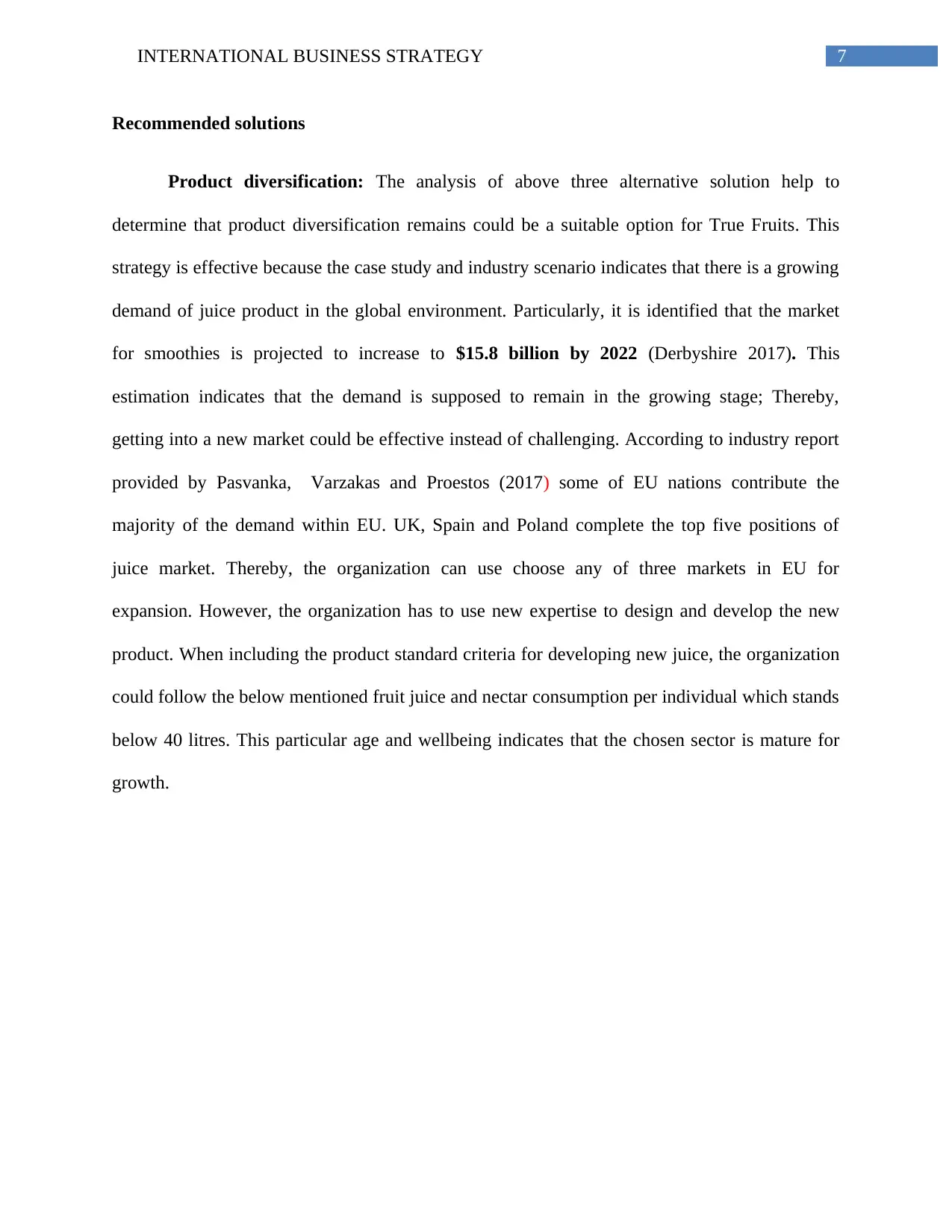
7INTERNATIONAL BUSINESS STRATEGY
Recommended solutions
Product diversification: The analysis of above three alternative solution help to
determine that product diversification remains could be a suitable option for True Fruits. This
strategy is effective because the case study and industry scenario indicates that there is a growing
demand of juice product in the global environment. Particularly, it is identified that the market
for smoothies is projected to increase to $15.8 billion by 2022 (Derbyshire 2017). This
estimation indicates that the demand is supposed to remain in the growing stage; Thereby,
getting into a new market could be effective instead of challenging. According to industry report
provided by Pasvanka, Varzakas and Proestos (2017) some of EU nations contribute the
majority of the demand within EU. UK, Spain and Poland complete the top five positions of
juice market. Thereby, the organization can use choose any of three markets in EU for
expansion. However, the organization has to use new expertise to design and develop the new
product. When including the product standard criteria for developing new juice, the organization
could follow the below mentioned fruit juice and nectar consumption per individual which stands
below 40 litres. This particular age and wellbeing indicates that the chosen sector is mature for
growth.
Recommended solutions
Product diversification: The analysis of above three alternative solution help to
determine that product diversification remains could be a suitable option for True Fruits. This
strategy is effective because the case study and industry scenario indicates that there is a growing
demand of juice product in the global environment. Particularly, it is identified that the market
for smoothies is projected to increase to $15.8 billion by 2022 (Derbyshire 2017). This
estimation indicates that the demand is supposed to remain in the growing stage; Thereby,
getting into a new market could be effective instead of challenging. According to industry report
provided by Pasvanka, Varzakas and Proestos (2017) some of EU nations contribute the
majority of the demand within EU. UK, Spain and Poland complete the top five positions of
juice market. Thereby, the organization can use choose any of three markets in EU for
expansion. However, the organization has to use new expertise to design and develop the new
product. When including the product standard criteria for developing new juice, the organization
could follow the below mentioned fruit juice and nectar consumption per individual which stands
below 40 litres. This particular age and wellbeing indicates that the chosen sector is mature for
growth.
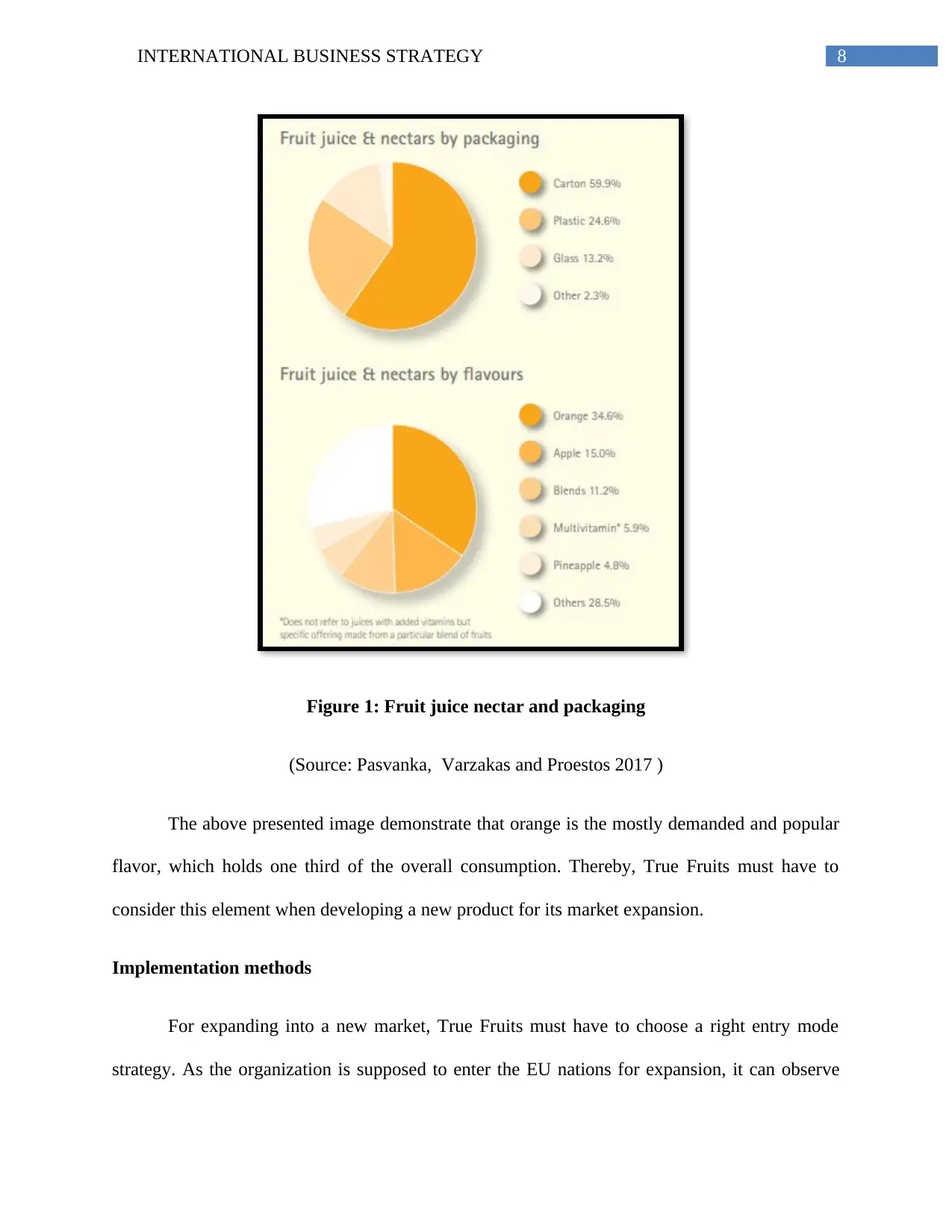
8INTERNATIONAL BUSINESS STRATEGY
Figure 1: Fruit juice nectar and packaging
(Source: Pasvanka, Varzakas and Proestos 2017 )
The above presented image demonstrate that orange is the mostly demanded and popular
flavor, which holds one third of the overall consumption. Thereby, True Fruits must have to
consider this element when developing a new product for its market expansion.
Implementation methods
For expanding into a new market, True Fruits must have to choose a right entry mode
strategy. As the organization is supposed to enter the EU nations for expansion, it can observe
Figure 1: Fruit juice nectar and packaging
(Source: Pasvanka, Varzakas and Proestos 2017 )
The above presented image demonstrate that orange is the mostly demanded and popular
flavor, which holds one third of the overall consumption. Thereby, True Fruits must have to
consider this element when developing a new product for its market expansion.
Implementation methods
For expanding into a new market, True Fruits must have to choose a right entry mode
strategy. As the organization is supposed to enter the EU nations for expansion, it can observe
⊘ This is a preview!⊘
Do you want full access?
Subscribe today to unlock all pages.

Trusted by 1+ million students worldwide
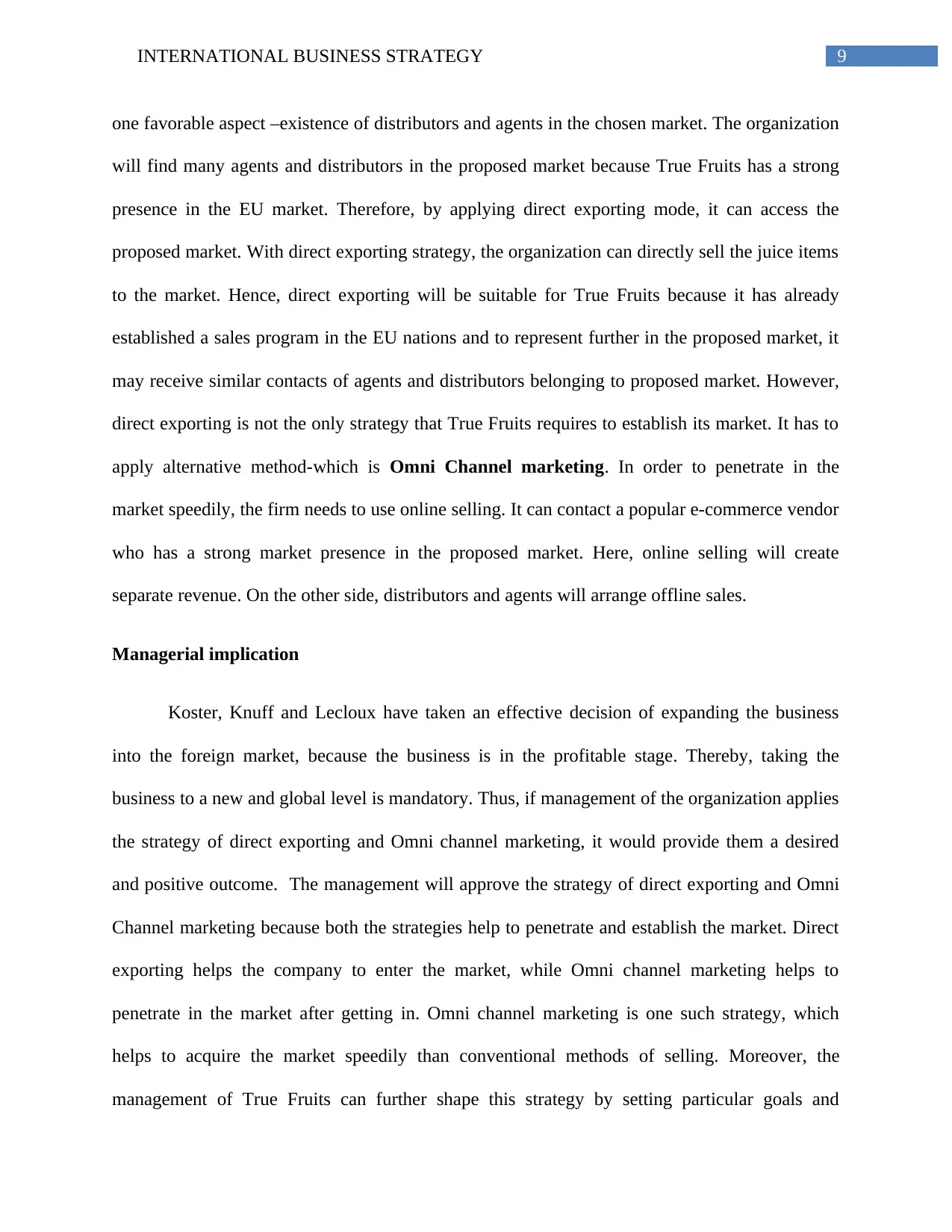
9INTERNATIONAL BUSINESS STRATEGY
one favorable aspect –existence of distributors and agents in the chosen market. The organization
will find many agents and distributors in the proposed market because True Fruits has a strong
presence in the EU market. Therefore, by applying direct exporting mode, it can access the
proposed market. With direct exporting strategy, the organization can directly sell the juice items
to the market. Hence, direct exporting will be suitable for True Fruits because it has already
established a sales program in the EU nations and to represent further in the proposed market, it
may receive similar contacts of agents and distributors belonging to proposed market. However,
direct exporting is not the only strategy that True Fruits requires to establish its market. It has to
apply alternative method-which is Omni Channel marketing. In order to penetrate in the
market speedily, the firm needs to use online selling. It can contact a popular e-commerce vendor
who has a strong market presence in the proposed market. Here, online selling will create
separate revenue. On the other side, distributors and agents will arrange offline sales.
Managerial implication
Koster, Knuff and Lecloux have taken an effective decision of expanding the business
into the foreign market, because the business is in the profitable stage. Thereby, taking the
business to a new and global level is mandatory. Thus, if management of the organization applies
the strategy of direct exporting and Omni channel marketing, it would provide them a desired
and positive outcome. The management will approve the strategy of direct exporting and Omni
Channel marketing because both the strategies help to penetrate and establish the market. Direct
exporting helps the company to enter the market, while Omni channel marketing helps to
penetrate in the market after getting in. Omni channel marketing is one such strategy, which
helps to acquire the market speedily than conventional methods of selling. Moreover, the
management of True Fruits can further shape this strategy by setting particular goals and
one favorable aspect –existence of distributors and agents in the chosen market. The organization
will find many agents and distributors in the proposed market because True Fruits has a strong
presence in the EU market. Therefore, by applying direct exporting mode, it can access the
proposed market. With direct exporting strategy, the organization can directly sell the juice items
to the market. Hence, direct exporting will be suitable for True Fruits because it has already
established a sales program in the EU nations and to represent further in the proposed market, it
may receive similar contacts of agents and distributors belonging to proposed market. However,
direct exporting is not the only strategy that True Fruits requires to establish its market. It has to
apply alternative method-which is Omni Channel marketing. In order to penetrate in the
market speedily, the firm needs to use online selling. It can contact a popular e-commerce vendor
who has a strong market presence in the proposed market. Here, online selling will create
separate revenue. On the other side, distributors and agents will arrange offline sales.
Managerial implication
Koster, Knuff and Lecloux have taken an effective decision of expanding the business
into the foreign market, because the business is in the profitable stage. Thereby, taking the
business to a new and global level is mandatory. Thus, if management of the organization applies
the strategy of direct exporting and Omni channel marketing, it would provide them a desired
and positive outcome. The management will approve the strategy of direct exporting and Omni
Channel marketing because both the strategies help to penetrate and establish the market. Direct
exporting helps the company to enter the market, while Omni channel marketing helps to
penetrate in the market after getting in. Omni channel marketing is one such strategy, which
helps to acquire the market speedily than conventional methods of selling. Moreover, the
management of True Fruits can further shape this strategy by setting particular goals and
Paraphrase This Document
Need a fresh take? Get an instant paraphrase of this document with our AI Paraphraser
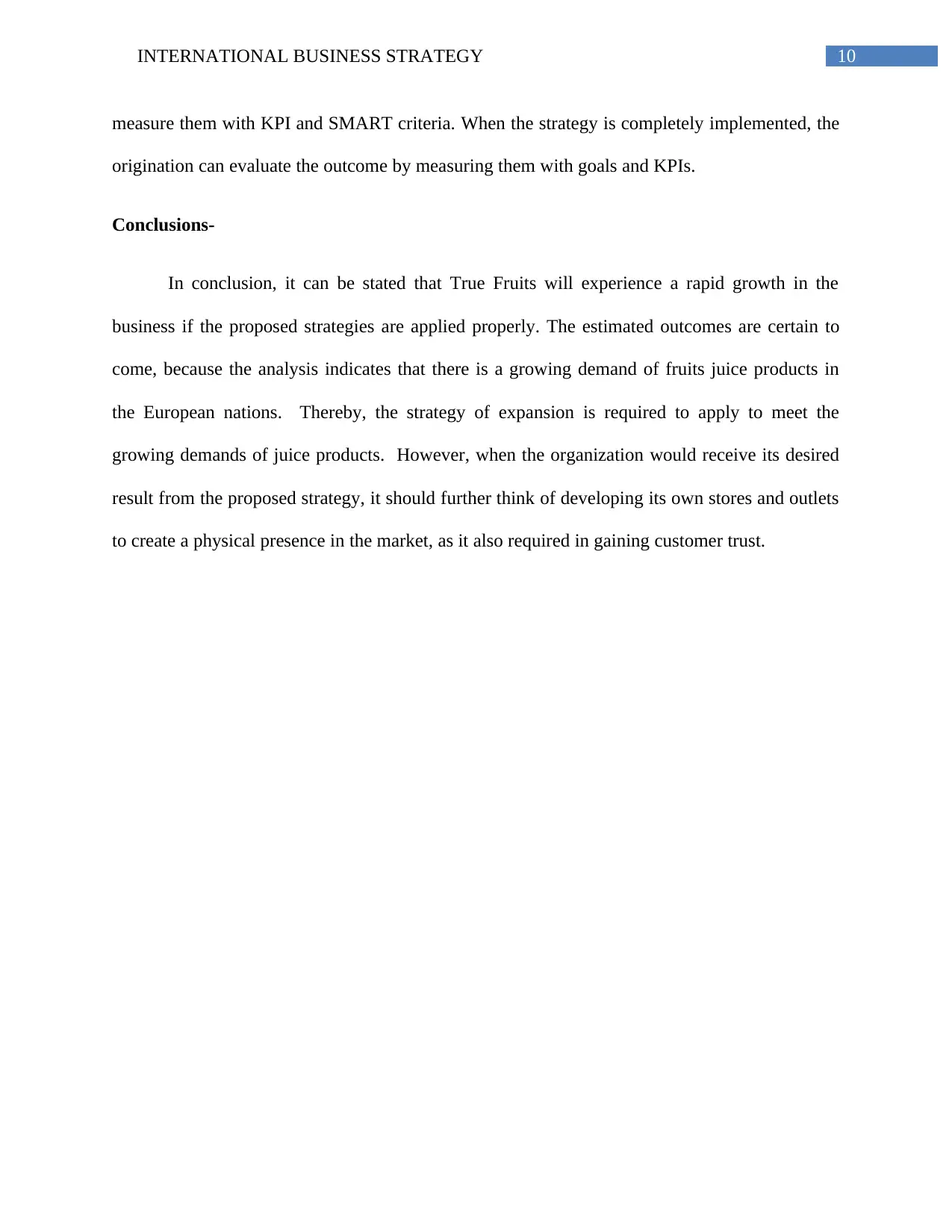
10INTERNATIONAL BUSINESS STRATEGY
measure them with KPI and SMART criteria. When the strategy is completely implemented, the
origination can evaluate the outcome by measuring them with goals and KPIs.
Conclusions-
In conclusion, it can be stated that True Fruits will experience a rapid growth in the
business if the proposed strategies are applied properly. The estimated outcomes are certain to
come, because the analysis indicates that there is a growing demand of fruits juice products in
the European nations. Thereby, the strategy of expansion is required to apply to meet the
growing demands of juice products. However, when the organization would receive its desired
result from the proposed strategy, it should further think of developing its own stores and outlets
to create a physical presence in the market, as it also required in gaining customer trust.
measure them with KPI and SMART criteria. When the strategy is completely implemented, the
origination can evaluate the outcome by measuring them with goals and KPIs.
Conclusions-
In conclusion, it can be stated that True Fruits will experience a rapid growth in the
business if the proposed strategies are applied properly. The estimated outcomes are certain to
come, because the analysis indicates that there is a growing demand of fruits juice products in
the European nations. Thereby, the strategy of expansion is required to apply to meet the
growing demands of juice products. However, when the organization would receive its desired
result from the proposed strategy, it should further think of developing its own stores and outlets
to create a physical presence in the market, as it also required in gaining customer trust.
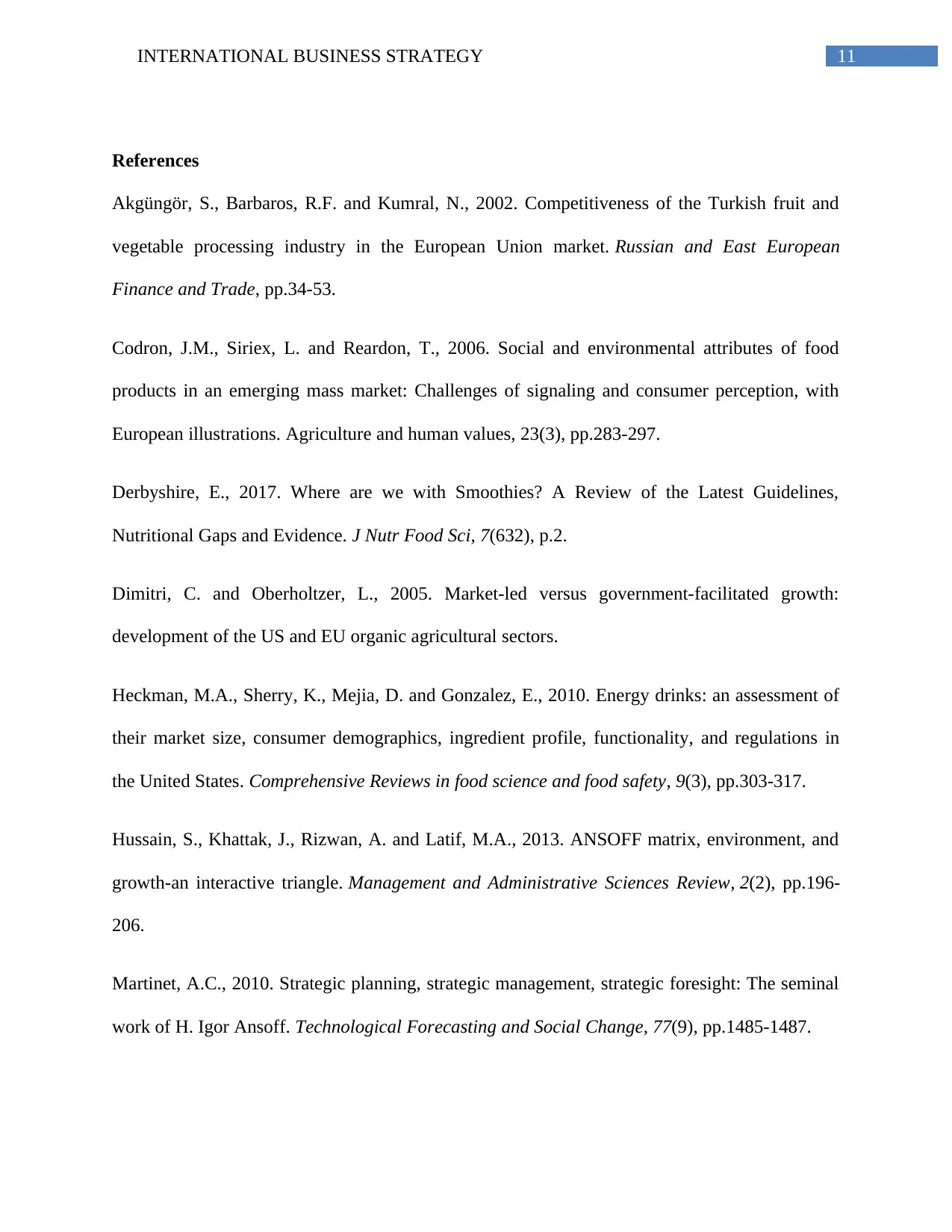
11INTERNATIONAL BUSINESS STRATEGY
References
Akgüngör, S., Barbaros, R.F. and Kumral, N., 2002. Competitiveness of the Turkish fruit and
vegetable processing industry in the European Union market. Russian and East European
Finance and Trade, pp.34-53.
Codron, J.M., Siriex, L. and Reardon, T., 2006. Social and environmental attributes of food
products in an emerging mass market: Challenges of signaling and consumer perception, with
European illustrations. Agriculture and human values, 23(3), pp.283-297.
Derbyshire, E., 2017. Where are we with Smoothies? A Review of the Latest Guidelines,
Nutritional Gaps and Evidence. J Nutr Food Sci, 7(632), p.2.
Dimitri, C. and Oberholtzer, L., 2005. Market-led versus government-facilitated growth:
development of the US and EU organic agricultural sectors.
Heckman, M.A., Sherry, K., Mejia, D. and Gonzalez, E., 2010. Energy drinks: an assessment of
their market size, consumer demographics, ingredient profile, functionality, and regulations in
the United States. Comprehensive Reviews in food science and food safety, 9(3), pp.303-317.
Hussain, S., Khattak, J., Rizwan, A. and Latif, M.A., 2013. ANSOFF matrix, environment, and
growth-an interactive triangle. Management and Administrative Sciences Review, 2(2), pp.196-
206.
Martinet, A.C., 2010. Strategic planning, strategic management, strategic foresight: The seminal
work of H. Igor Ansoff. Technological Forecasting and Social Change, 77(9), pp.1485-1487.
References
Akgüngör, S., Barbaros, R.F. and Kumral, N., 2002. Competitiveness of the Turkish fruit and
vegetable processing industry in the European Union market. Russian and East European
Finance and Trade, pp.34-53.
Codron, J.M., Siriex, L. and Reardon, T., 2006. Social and environmental attributes of food
products in an emerging mass market: Challenges of signaling and consumer perception, with
European illustrations. Agriculture and human values, 23(3), pp.283-297.
Derbyshire, E., 2017. Where are we with Smoothies? A Review of the Latest Guidelines,
Nutritional Gaps and Evidence. J Nutr Food Sci, 7(632), p.2.
Dimitri, C. and Oberholtzer, L., 2005. Market-led versus government-facilitated growth:
development of the US and EU organic agricultural sectors.
Heckman, M.A., Sherry, K., Mejia, D. and Gonzalez, E., 2010. Energy drinks: an assessment of
their market size, consumer demographics, ingredient profile, functionality, and regulations in
the United States. Comprehensive Reviews in food science and food safety, 9(3), pp.303-317.
Hussain, S., Khattak, J., Rizwan, A. and Latif, M.A., 2013. ANSOFF matrix, environment, and
growth-an interactive triangle. Management and Administrative Sciences Review, 2(2), pp.196-
206.
Martinet, A.C., 2010. Strategic planning, strategic management, strategic foresight: The seminal
work of H. Igor Ansoff. Technological Forecasting and Social Change, 77(9), pp.1485-1487.
⊘ This is a preview!⊘
Do you want full access?
Subscribe today to unlock all pages.

Trusted by 1+ million students worldwide
1 out of 14
Related Documents
Your All-in-One AI-Powered Toolkit for Academic Success.
+13062052269
info@desklib.com
Available 24*7 on WhatsApp / Email
![[object Object]](/_next/static/media/star-bottom.7253800d.svg)
Unlock your academic potential
Copyright © 2020–2025 A2Z Services. All Rights Reserved. Developed and managed by ZUCOL.




